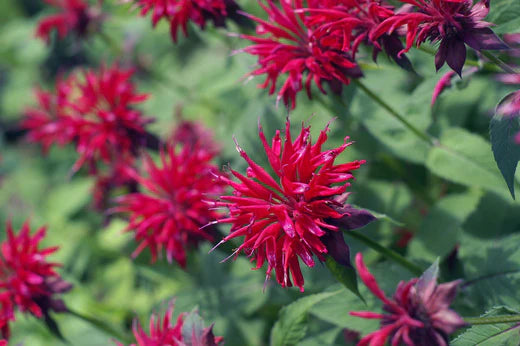The most popular name for the Monarda genus, which is a member of the Lamiaceae family of mint plants, is "bee balm." Most often, it can be found in North America. These flowers have one of the most remarkable appearances thanks to their vibrant hue. It is perennial and appears in the summer. This plant is commonly utilized in gardening because of the alluring beauty of its blossoms. Flowers are asymmetrical, two-lipped, and densely populated with globular terminal heads. For the roughly 16 species that are local to the region, they are extensively cultivated in North America. The spreading stems are tall and strong. These blooms are reported to have a delicate beauty and exceptional lifespan. Bee balm is resistant to harsh and unpredictable weather. Typically, the hue of its blossoms is pink, red, or lavender. Its name derives from the plant's strong attraction to bees. You may plant it alongside a plant that needs bees to pollinate it. Due to the fact that it is a perennial plant, beautiful flower growth is only seen in the second and later years. For those who want to develop tough vegetables and floral plants, bee balm is a fantastic plant.
However, bee balm has several medical uses in addition to luring hummingbirds and butterflies, and it also has a very pleasant flavor.
General Description
These are perennial perennials, reaching heights of 20 to 90 cm. On the hairless or sparsely haired stem, oppositely oriented, serrated, slender, lanceolate leaves are placed. Flowers are bilaterally symmetrical, and tubular, and have lips that are alternately wide and small. The stem is 7–14 cm long. While the wild variety of the plant only has one blossom, cultivated varieties have two. Both male and female structures can be found in flowers. They typically grow in groups and have leafy bracts. The blossoms might be pink, purple, or red in color.
- Common Name- Bee balm, bergamot, horsemint, oswego tea
- Botanical Name- Monarda didyma
- Chinese Name- Mei Guo Bo He
- Family- Lamiaceae
Cultivation
Bee balm plants thrive in partially shaded areas with well-drained soil. For two blooms to grow properly, there should be at least 18 to 24 inches between them.
It is typically grown for gardening purposes and is also used to draw bees, butterflies, and hummingbirds. Some of its hybrids have also been created so that their essential oils can be used in cooking. The strength of wildflowers is greater than that of cultivated ones.
Medicinal Properties
- Digestive
- Decongestant
- Antimicrobial
- Analgesic
- Antispasmodic
- Antifungal
- Nervine tonic
- Anti-inflammatory
- Nutritional
- Anti-irritant
Therapeutic Properties
- Dental cavities, gingivitis, and toothaches can all be treated with this plant thanks to its anti-inflammatory and antibacterial characteristics.
- It is an effective digestive that soothes indigestion, nausea, and vomiting. Bee balm helps with digestion and treats illnesses brought on by poor digestion.
- This herb's antispasmodic properties aid in naturally treating cough and menstrual cramps.
- Bee balm can be used to reduce bloating as well.
- Because it has anti-irritant and anti-inflammatory characteristics, applying locally to bee sting, scrape, or rash sites decreases the irritation, pain, and swelling of the affected area.
- Its calming impact on the neurological system and on nerves aids in the natural treatment of stress and anxiety. This is often referred to as a nervine tonic.
- All digestive issues, including indigestion, bloating, and gas generation, can be relieved with herbal tea made from bee balm. Fresh petals or dried flowers can both be used to make the tea.
- This decongestant and antibacterial characteristics aid in the natural relief of cold and cough.
- This herb's balm or steam inhalation both aid in clearing blocked nasal passages.
- Due to the herb's anti-inflammatory and relaxing qualities, mouthwash made from its decoction can aid in the treatment of sore throats and mouth ulcers.
- Because of its delicious flavor, bee balm can also be used for eating or cooking. It can be used as a salad dressing, in cookies, bread, and muffins, or it can be used to make vinegar by combining it with apple cider vinegar.

